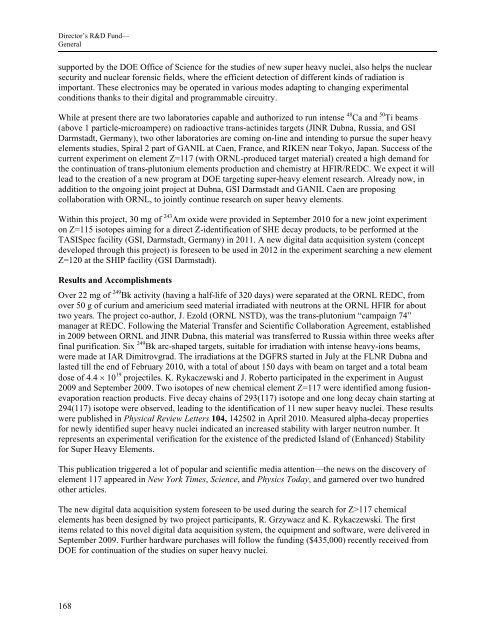FY2010 - Oak Ridge National Laboratory
FY2010 - Oak Ridge National Laboratory
FY2010 - Oak Ridge National Laboratory
You also want an ePaper? Increase the reach of your titles
YUMPU automatically turns print PDFs into web optimized ePapers that Google loves.
Director’s R&D Fund—<br />
General<br />
supported by the DOE Office of Science for the studies of new super heavy nuclei, also helps the nuclear<br />
security and nuclear forensic fields, where the efficient detection of different kinds of radiation is<br />
important. These electronics may be operated in various modes adapting to changing experimental<br />
conditions thanks to their digital and programmable circuitry.<br />
While at present there are two laboratories capable and authorized to run intense 48 Ca and 50 Ti beams<br />
(above 1 particle-microampere) on radioactive trans-actinides targets (JINR Dubna, Russia, and GSI<br />
Darmstadt, Germany), two other laboratories are coming on-line and intending to pursue the super heavy<br />
elements studies, Spiral 2 part of GANIL at Caen, France, and RIKEN near Tokyo, Japan. Success of the<br />
current experiment on element Z=117 (with ORNL-produced target material) created a high demand for<br />
the continuation of trans-plutonium elements production and chemistry at HFIR/REDC. We expect it will<br />
lead to the creation of a new program at DOE targeting super-heavy element research. Already now, in<br />
addition to the ongoing joint project at Dubna, GSI Darmstadt and GANIL Caen are proposing<br />
collaboration with ORNL, to jointly continue research on super heavy elements.<br />
Within this project, 30 mg of 243 Am oxide were provided in September 2010 for a new joint experiment<br />
on Z=115 isotopes aiming for a direct Z-identification of SHE decay products, to be performed at the<br />
TASISpec facility (GSI, Darmstadt, Germany) in 2011. A new digital data acquisition system (concept<br />
developed through this project) is foreseen to be used in 2012 in the experiment searching a new element<br />
Z=120 at the SHIP facility (GSI Darmstadt).<br />
Results and Accomplishments<br />
Over 22 mg of 249 Bk activity (having a half-life of 320 days) were separated at the ORNL REDC, from<br />
over 50 g of curium and americium seed material irradiated with neutrons at the ORNL HFIR for about<br />
two years. The project co-author, J. Ezold (ORNL NSTD), was the trans-plutonium “campaign 74”<br />
manager at REDC. Following the Material Transfer and Scientific Collaboration Agreement, established<br />
in 2009 between ORNL and JINR Dubna, this material was transferred to Russia within three weeks after<br />
final purification. Six 249 Bk arc-shaped targets, suitable for irradiation with intense heavy-ions beams,<br />
were made at IAR Dimitrovgrad. The irradiations at the DGFRS started in July at the FLNR Dubna and<br />
lasted till the end of February 2010, with a total of about 150 days with beam on target and a total beam<br />
dose of 4.4 10 19 projectiles. K. Rykaczewski and J. Roberto participated in the experiment in August<br />
2009 and September 2009. Two isotopes of new chemical element Z=117 were identified among fusionevaporation<br />
reaction products. Five decay chains of 293(117) isotope and one long decay chain starting at<br />
294(117) isotope were observed, leading to the identification of 11 new super heavy nuclei. These results<br />
were published in Physical Review Letters 104, 142502 in April 2010. Measured alpha-decay properties<br />
for newly identified super heavy nuclei indicated an increased stability with larger neutron number. It<br />
represents an experimental verification for the existence of the predicted Island of (Enhanced) Stability<br />
for Super Heavy Elements.<br />
This publication triggered a lot of popular and scientific media attention—the news on the discovery of<br />
element 117 appeared in New York Times, Science, and Physics Today, and garnered over two hundred<br />
other articles.<br />
The new digital data acquisition system foreseen to be used during the search for Z>117 chemical<br />
elements has been designed by two project participants, R. Grzywacz and K. Rykaczewski. The first<br />
items related to this novel digital data acquisition system, the equipment and software, were delivered in<br />
September 2009. Further hardware purchases will follow the funding ($435,000) recently received from<br />
DOE for continuation of the studies on super heavy nuclei.<br />
168
















